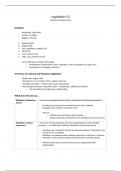Legislation (1)
Laboratory animal science
Numbers
- Worldwide: 100 million
- Europe: 12 million
- Belgium: 700.708
1. Rodents (81%)
2. Rabbits (9%)
3. Fish, amphibians, reptiles (5%)
4. Birds (3%)
5. Farm animals (<1%)
6. Dogs, cats, primates (<0,1%)
- Use of laboratory animals is fluctuating
└ Development of alternatives, ethics, legislation, more responsible use, high costs:
└ Development of transgenic animals:
Overview of national and European legislation
- Belgian law: august 1986
- Royal Decree: 14 november 1993 = update of the law
- New BRD: april 2010 stricter rules concerning housing
- New European Directive: september 2010 include pain, suffering, discomfort
└ The translation into belgian law is still pending
What does the law say …
Definition of laboratory = every living vertebrate animal used or intended for laboratory experiments
animal
- Including: free living and/or reproducing larval forms (axolotl)
- Excluding: other foetal or embryonic forms
- New law
└ Include some invertebrae (squid, lobster, …)
└ Include mammalian embryonic forms starting from last 1/3 of term
Definition of animal = every use of living vertebrate animal for experimental an other scientific
experiment purposes can inflict pain, suffering, discomfort or permanent injury
- Including: every treatment with the purpose/consequence of the birth of an
animal in such a condition
- Excluding: non-experimental treatments (agriculture, veterinary) + humane
methods (= least painful accepted methods to kill or mark the animal)
Animals should not be used more than once in experiments with
suffering/pain
,Degrees of pain/suffering
Mild pain - Administration anaethesia
- Non-invasive imaging (MRI)
- Superficial procedures (ear/tail biopsies)
Moderate pain - Surgery under general anaesthesia + post-surgical pain
- Induction of tumours +development spontaneous tumour
- Irradiation with sublethal dose
Serious pain - Toxicity + vaccine potency testing
- Irradiation with lethal dose
Purpose of laboratory animals
- Production + control of sera, vaccines or diagnostics
- Toxicological/ pharmacological research
- Diagnose of disease
- Education
- Answer scientific questions
Not allowed to test cosmetic products
Housing and taking care of lab animals
Detailed overview per species described in legislation
- Housing conditions, environment, space to move, feed, water and care: meet animal needs
- Daily control of animals + environment (including weekend/holidays)
- Regular control by vet
Source and identification of laboratory animals
- No stray pets, lost/abandoned animals
- Purpose-bred by licensed companies
- Farm animals
- Special demands for threatened species living in the wild
- Dogs, cats & primates
└ Marked individually and permanent
└ Immediately after weaning
- Register all animals joining & leaving the lab
Statistical information
- Handed to the government every year
└ Numbers used per species
└ Numbers per type of experiment
,Responsible use
- Experiments
└ Absolute minimum
└ Only if there is no alternative method
└ The choice of animal species must me considered
└ Lowest neurophysiological degree
- Never be subject to serious pain, great discomfort or suffering
└ If not avoided under anaesthesia
└ If anaesthesia is not possible analgesics (decrease pain)
The 3 R’s
Reduction Replacement Refinement
- Choosing well the - Replacing animal - Gathering knowledge about
experimental design experiments with another biological needs
- Standardising the lab animal method or invertebrate - Less discomfort
population and the - Environmental enrichment
experimental procedures - Apply analgesia
What to do before starting experiment
1. Laboratory license: Federal public service - Animal Welfare
└ Overview & map of the rooms
└ Overview of the kind of experiments
└ List of species and their source
└ Overview of the staff
Laboratory director = responsible manager
Expert Protection health & well-being
- Large: veterinarian
- Small: FELASCA C training
Project leader Experiment set up, log keeping
Biotechnicians Conduct experiments
Animal caretakers
2. Permission of the Ethical Committee: since 2001
└ Tasks
Evaluation of planned experiments
Setting up ethical criteria
Advising labo’s ands government
Reporting to the government
└ Professional secrecy for the members
, └ Members
Laboratory director
Project leader
Veterinarian or expert
Biotechnician
2 independent members (skills needed)
└ Apply for the permission, describe the …
Staff responsible for project
Purpose and description
Number and species of animals, degree and duration of pain
Anaesthesia and analgesia that will be used, post-operative care
Alternative methods
Humane endpoints and euthanasia
3. Education: october 2004 (FELASA)
└ Project leaders: 80h course
└ Researchers and lab technicians: 40h course
└ Animal caretakers: 25h course
Other paperwork:
4. Import license: importing animals from non-EU member states
5. Bio-security dossier
6. Radio-activity use in lab animals
Changes in legislation
- What we already had
└ Definition laboratory animal
└ Composition ethical committee
└ Continuous education
What else is there?
1. Animal welfare body
└ Set-up by every user
└ Include animal caretakers, scientist, veterinarian of expert
└ Tasks
Advise on animal welfare: accommodation, care and use
Review internal operational processes
└ Ultimate goal = improve animal welfare
Better follow-up of humane endpoints
Improve protocols ex. Anesthesia, analgesia
└ Other goal = improve transparency
Rules/laws are followed
2. More animals in the statistics: reporting all animals used in the creation of a new line




